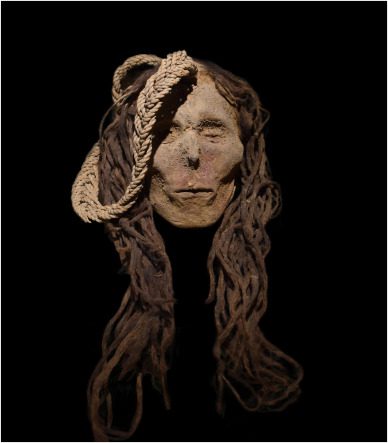A child who had the honor of being made into a trophy head by the ancient Nazca culture of southern Peru was drugged up on a mescaline-containing cactus prior to being sacrificed, a new analysis has revealed. The same study also found evidence of ayahuasca use among other mummified individuals from the Early Nazca Period – which ran from 100 BCE to 450 CE – and therefore provides the earliest archaeological evidence for the consumption of these two psychedelic plants.
Though the use of hallucinogenic substances was common throughout South America in pre-Columbian times, little is known about which concoctions were ritually consumed during the Early Nazca Period. To investigate, researchers analyzed hair samples from 22 individuals from three separate Nazca sites.
Famous for their incredible geoglyphs – known as the Nazca Lines – the Nazca were also prolific collectors of trophy heads. So far, about 150 such heads have been discovered, although scholars are unsure if these were removed from the shoulders of sacrificial victims or enemy warriors during battle.
Among the 22 specimens assessed in the study were four trophy heads, including a child of unknown sex, an adult female and two adult males. When conducting their analysis, the study authors searched for metabolites of the coca plant – such as cocaine and benzoylecgonine – as well as mescaline and other compounds found in the psychedelic Amazonian brew ayahuasca.
A Nazca trophy head belonging to a female victim. Image credit: D. Socha
Reporting their findings, the researchers explain that “the level of the mescaline in the child’s hair suggested a high consumption of the San Pedro cactus.” Named after Saint Peter – who holds the keys to heaven – San Pedro has been used as a sacrament by Indigenous Andean cultures for millennia. Interestingly, the psychedelic cactus is also known by its Quechua name “Huachuma”, which roughly translates as “removing the head”.
At the same time, the authors discovered that the female victim had chewed coca leaves, while neither of the adult male trophy heads showed any signs of drug use. Based on these findings, the researchers speculate that the woman and child may have been ritually sacrificed before having their heads removed and that their consumption of coca and San Pedro might have formed part of the ceremony.
In contrast, the male heads may have been captured during warfare, thus explaining why these victims were not supplied with any substances before being dispatched.
This hypothesis is supported by evidence that the more recent Inca civilization gave ayahuasca to child sacrifice victims as an anti-depressant while they awaited their fate. However, as the study authors note, “this is the first proof that some of the victims transformed into trophy heads were given stimulants prior to their death.”
Turning their attention to the 18 remaining Nazca specimens, the researchers found ayahuasca compounds in the hair of two further individuals. Concentrations of these substances in the hair of one mummy “far exceeded any previous investigated ancient samples, suggesting a possible shamanistic occupation of this individual.”
Coca metabolites, meanwhile, were present in five samples, including a six-month infant who probably ingested the substance via its mother’s breastmilk.
Collectively, these findings represent the earliest evidence for the use of San Pedro and ayahuasca, while also confirming for the first time that coca leaves were present on the southern Peruvian coast during the Early Nazca Period.
The study has been published in the Journal of Archaeological Science.
Source Link: Ancient "Trophy Head" Child Was High On Psychedelic Cactus Before Ritual Sacrifice
